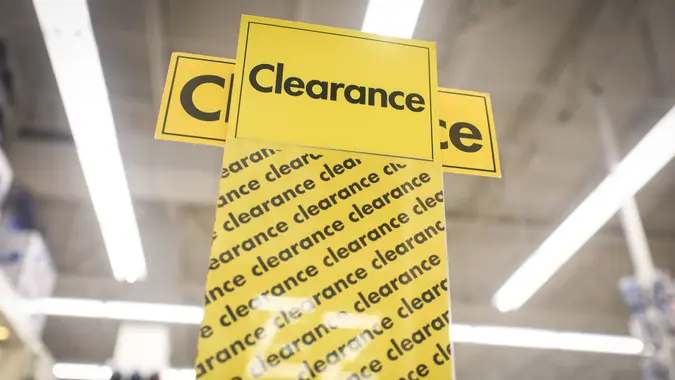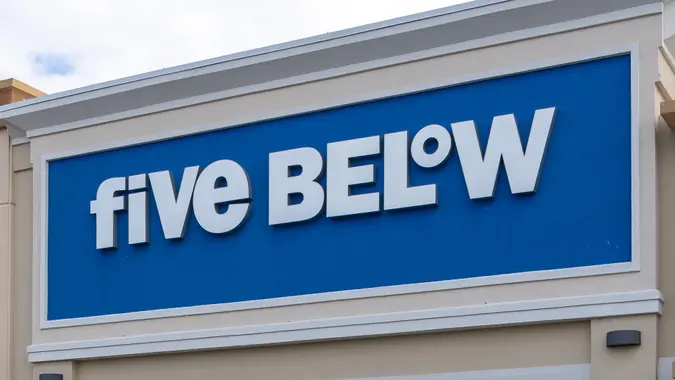How Much Is a Typical Water Bill in 2025: Monthly Averages Across the U.S.

Commitment to Our Readers
GOBankingRates' editorial team is committed to bringing you unbiased reviews and information. We use data-driven methodologies to evaluate financial products and services - our reviews and ratings are not influenced by advertisers. You can read more about our editorial guidelines and our products and services review methodology.

20 Years
Helping You Live Richer

Reviewed
by Experts

Trusted by
Millions of Readers
Monthly bills are unavoidable, and with prices rising on everything from groceries to utilities, it’s more important than ever to plan ahead. If you’ve ever wondered, “How much is a typical water bill?” the average in 2025 is around $73 per month. While your exact costs may vary based on usage, having a general estimate can help you budget more confidently and avoid surprise expenses.
Average Monthly Water Bill in the U.S.
Your average water bill depends on factors such as the number of people living in your house, leaks, your region, service provider and general water consumption each day.
Here are some key statistics to know:
- The typical monthly water bill in the U.S. is around $73 per month.
- The bill amounts range from $20 to $105 per month, according to data from Statista.
- The average monthly utility bill, including electricity, water, gas, streaming, cable, internet, sewer, garbage and recycling is around $583 per month.
- Water usage that can increase your bill includes taking long showers, using inefficient appliances, hot water settings on your washing machine and more.
How Much Is a Typical Water Bill in Each State?
Wondering how much is a typical water bill in your state? It depends on the location, provider and daily water habits. Some water bills include sewer service fees and some locations such as California have expensive infrastructure maintenance.
With that in mind, here’s a look at average monthly water bills for each state:
| State | Average Water Bill |
|---|---|
| Alabama | $24 |
| Alaska | $87 |
| Arizona | $53 |
| Arkansas | $24 |
| California | $76 |
| Colorado | $41 |
| Connecticut | $41 |
| Delaware | $48 |
| Florida | $34 |
| Georgia | $28 |
| Hawaii | $64 |
| Idaho | $49 |
| Illinois | $26 |
| Indiana | $31 |
| Iowa | $33 |
| Kansas | $31 |
| Kentucky | $31 |
| Louisiana | $34 |
| Maine | $22 |
| Maryland | $50 |
| Massachusetts | $33 |
| Michigan | $29 |
| Minnesota | $30 |
| Mississippi | $35 |
| Missouri | $42 |
| Montana | $41 |
| Nebraska | $32 |
| Nevada | $50 |
| New Hampshire | $28 |
| New Jersey | $71 |
| New Mexico | $33 |
| New York | $30 |
| North Carolina | $20 |
| North Dakota | $42 |
| Ohio | $28 |
| Oklahoma | $39 |
| Oregon | $89 |
| Pennsylvania | $31 |
| Rhode Island | $33 |
| South Carolina | $31 |
| South Dakota | $26 |
| Tennessee | $36 |
| Texas | $45 |
| Utah | $41 |
| Vermont | $21 |
| Virginia | $36 |
| Washington | $78 |
| West Virginia | $105 |
| Wisconsin | $21 |
| Wyoming | $74 |
How the Average Household Uses Water
Here’s a breakdown of the average household water use by activity, according to a Water Research Foundation survey:
| Activity | Gallons Per Day, Per Person | Percentage of Total Use |
|---|---|---|
| Toilet | 18.5 gallons | 24% |
| Shower | 11.6 gallons | 20% |
| Faucet | 10.9 gallons | 19% |
| Washing machine | 15 gallons | 17% |
5 Ways To Lower Your Water Bill
Water bills can fluctuate based on usage and type of appliances. There are ways to lower this cost by developing a few habits. Here are a few helpful tips to save money on your water bill:
- Shorten your showers:
- It may be relaxing to linger in the shower but to lower your bill, make sure you are taking quick showers. You can also install a low-flow shower head to help.
- Use your dishwasher:
- Washing dishes by hand and leaving the water running actually uses more water than a regular dishwasher cycle.
- Don’t let water run:
- This includes turning off the faucet when brushing your teeth or lathering your hands with soap when washing them.
- Reevaluate your lawn care:
- It’s always nice to have healthy grass but watering your lawn, garden or plants takes gallons of water. Cutting back could save you on your water bill. If you live in a climate where there isn’t much rainfall, you could consider synthetic grass.
- Fix any leaks:
- If you have faucets that drip or toilets that run, you might consider fixing them to save several dollars on your monthly bills.
How To Understand Your Water Bill
Understanding your water bill can seem challenging with all of the included figures and varying amounts, so here’s how to break it down.
- Know the two main charge types:
- Fixed fees stay the same each month. These usually cover service costs like billing, meter maintenance and customer support.
- Usage-based fees depend on how much water you use.
- Gallons vs. CCF:
- Water usage is usually measured in gallons or centum cubic feet. One CCF equals 748 gallons. Check your bill to see which measurement your utility company uses.
- Understand rate structures:
- Water companies may use different pricing models:
- Uniform rate: You pay the same price per gallon, no matter how much you use.
- Increasing block rate: The more you use, the more you pay per gallon. For example, rates rise after each usage block — 1,000, 2,000, 3,000 gallons.
- Seasonal rate: Higher prices during peak demand seasons, like summer, and lower prices in off-peak times.
- Water budget-based rule: Based on your household size or lot size. You’ll pay a higher bill if you exceed your budgeted use.
- Water companies may use different pricing models:
Utility companies can vary widely regarding specific line item charges and how they charge. If you have any questions about your water bill or any of its charges, it’s best to contact your utility company.
FAQ
Here are the answers to some of the most frequently asked questions about water bills.- What is the average water bill for a single person?
- The water bill for a single person on average is around $18.25
- Why did my water bill go up suddenly?
- If your water bill increased significantly, it could be due to a leak, such as from a broken water pipe or a leak in the service line between the water meter and your home.
- Other reasons a water bill might noticeably increase include seasonal use, like heavily watering the yard or filling a swimming pool.
- How is water usage measured?
- Utility companies measure water in gallons or centum cubic feet. One CCF equals 748 gallons.
- Does running the dishwasher use more water than handwashing?
- No. Studies show that handwashing dishes uses 3.5 times more water than a dishwasher does.
Data is accurate as of May 6, 2025, and is subject to change.
Caitlyn Moorhead contributed to the reporting for this article.
Our in-house research team and on-site financial experts work together to create content that’s accurate, impartial, and up to date. We fact-check every single statistic, quote and fact using trusted primary resources to make sure the information we provide is correct. You can learn more about GOBankingRates’ processes and standards in our editorial policy.
- LawnStarter. 2024. "How Much is the Average Water Bill in 2025?"
- Move.org. 2024. "Utility Bills 101: Average Monthly Cost of Utilities by State and Nationally."
- Statista. 2024. "Average monthly water bills in the United States as of 2024, by state."
- United States Environmental Protection Agency. 2025. "Statistics and Facts."
- Lewis and Clark Natural Resources District. "Helpful Hints to Detect a Water Leak."
- Town of Mount Airy. "Potential Causes of High Water Bills."
- United States Environmental Protection Agency. 2025. "Understanding Your Water Bill"
 Written by
Written by  Edited by
Edited by 

























